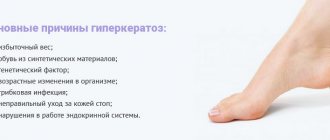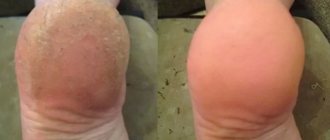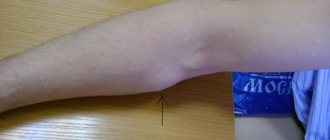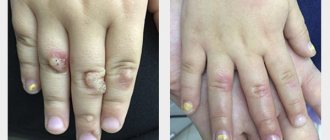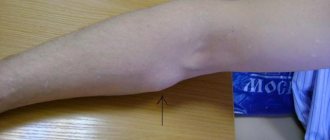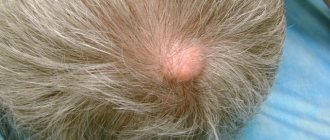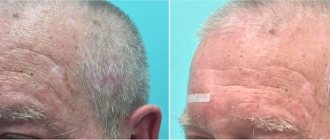Attention!
The presented material is of an informational nature and is aimed at podologists who can take a refresher course on this topic.
CHTA is an educational organization, so treatment consultations are not provided. Our specialists can provide assistance only in matters of obtaining additional professional education - advanced training courses and professional retraining.
Calluses are a problem that every modern person inevitably faces at least once. Uncomfortable shoes, long walks or working on your feet, thin skin – there are many reasons that contribute to the appearance of this unpleasant formation.
How to get rid of dry callus on your finger?
How to quickly get rid of calluses on your feet?
Calluses on feet: how to get rid of them?
How to get rid of callus at home
How to get rid of a callus on the foot?
How to get rid of calluses between your fingers?
In addition to the fact that calluses look unaesthetic, they are also sometimes very painful. Since few people agree to endure discomfort, there are probably a thousand and one ways to get rid of the problem with the help of drugs and products that can be found in any home. The effectiveness of such “grandfathered” methods has not been proven, however, recipes for medicinal mixtures are passed down from generation to generation, which proves their relevance.
How to get rid of dry callus on your finger?
To begin with, it is worth noting the fact that calluses are divided into two types:
- dry;
- wet.
Dry calluses, also known as corns, are most easily removed with a rough pedicure file or regular pumice stone. The best effect is achieved if problem areas are treated dry, without steaming.
For those who still cannot do without first softening the skin, it is recommended to soak their feet in a mixture of soda (2 spoons), liquid soap (2 spoons) and hot water for half an hour. Such a bath will soften the rough epidermis and help remove corns faster than in the case of dry grinding.
Another option is to apply salicylic ointment (10%) to the callus at night. Fans of homemade recipes can prepare a homemade compress from the pulp of black bread, soaked in vinegar or lemon juice, with the addition of grated lemon zest. Regardless of which method you prefer, after lubricating the calluses on your foot, you need to put on a plastic bag and a warm sock. In the morning, all that remains is to cut off the already soft and pliable skin.
If we talk about pharmaceutical products, then a special medicinal patch helps to effectively get rid of corns. It is glued onto pre-steamed feet and changed every 24 hours for 3-4 days (until the callus is completely gone).
Now the question of how to get rid of calluses and corns will no longer arise for you.
What to do with hard calluses?
A hard callus is essentially a dry callus.
Naturally, you need to get rid of it.
Let's take a closer look at some official pharmaceutical products for the treatment of calluses.
Treated with Anticorn Super cream.
It is used to moisturize and gradually soften.
It contains many natural plant components with bactericidal and softening properties.
They are also treated with the oily liquid “Feresol” with a cauterizing effect due to the content of phenol and tricresol.
It also has antimicrobial, anti-inflammatory, bactericidal and softening effects.
They are also treated with a very effective remedy - Roacutane gel.
This gel has a keratolytic effect.
Due to the content of salicylic, lactic, boric, benzoic and citric acids in its composition.
And finally, a few words about the Salipoda patch.
This convenient patch has long proven its effectiveness.
It has a pronounced softening antimicrobial effect.
But before using these products, you must carefully re-read all contraindications and strictly adhere to them.
How to quickly get rid of calluses on your feet?
The second type of consequence of wearing tight shoes is water (wet) calluses. The fastest way to get rid of them is with a puncture. This method is controversial, since if the callus is damaged, there is a chance of infection. However, it cannot be denied that calluses freed from fluid heal much better than those that are not punctured.
If you nevertheless decide to “dry” the callus, then take care of sterility in advance: thoroughly wash your hands and the problem area itself, heat the tip of the needle over a fire or disinfect it with alcohol, prepare a napkin/gauze disinfected with an antiseptic to absorb the ichor from the callus.
After the callus is punctured, it must be treated with antimicrobial ointment and sealed with a medicinal plaster. At night, you can additionally apply products that accelerate tissue regeneration.
You can learn more about nutrition rules and the principles of forming a reasonable diet in a
7-module certification course in dietetics and nutrition from leading nutritionist Oleg Iryshkin.
Calluses on feet: how to get rid of them?
Calluses are hard, rough areas of skin with a dot (spot) in the center. They do not have a cavity, but they have a rod that goes deep into the thickness of the epidermis.
Calluses are a consequence of ignoring corns. The problem is most often localized on the heels and balls of the toes. People who wear uncomfortable shoes, suffer from fungal or viral skin infections, and often injure their feet (athletes, ballerinas, etc.) are at risk of developing such an unpleasant defect.
It is possible to remove calluses with a core at home, but doing it yourself is highly not recommended. The fact is that inept manipulations with periodically inflamed calluses are dangerous not only due to the increased likelihood of infection, but also to the risk of injury to the deep layers of the epidermis.
If you find a corn with a dot inside, it is better to immediately consult a dermatologist, who will offer you one of three options for solving the problem:
- Removal of the callus using a special cutter (the depression formed in the skin is filled with an antiseptic).
- Removing calluses with liquid nitrogen.
- Removal of calluses with a carbon dioxide laser (the most modern and effective method of treating calluses, eliminating the risk of inflammation).
All of the above procedures are painless, but in case of increased sensitivity they can be performed using local anesthesia.
3. Symptoms and diagnosis
There are several types of calluses, which differ significantly both etiologically and clinically. For example, a core callus is usually formed in response to the introduction of a small foreign body (a splinter, a chip that has gotten under the skin, a piece of stone, etc.) and is a compaction that goes deep, visible from the outside as a cap with a central crater. Corns are also a type of callus - keratinized areas on the soles of the feet, sometimes of a fairly large area, without a clear boundary with the skin of normal elasticity and moisture.
The most obvious and significant difference is between the two main categories of calluses: soft and dry.
Soft (water) calluses at the stage of formation are a locally irritated, reddened, weeping, painful area of skin, which quickly transforms into a blister or sac filled with serous fluid (“dropsy”); if the exposure does not stop at this stage, the soft callus inevitably breaks through to form an open wound. The penetration of pathogenic microorganisms triggers an infectious-inflammatory process, the classic signs of which are swelling, hyperemia, clearly localized pain, and local fever. The most serious of the complications mentioned above include purulent abscesses, cellulitis, and osteomyelitis.
The callus is dry (hard), looks like a local rounded keratinization, usually yellow-gray, with a radius of several millimeters to several centimeters, clearly demarcated from the surrounding skin and rising (sometimes significantly) above its level. Any pain or discomfort occurs, as a rule, only when such a callus is pressed or laterally displaced.
The most common areas for the formation of calluses are the distal, terminal sections of the hands and feet (phalangeal folds, fingertips, interdigital spaces, skin of the palms and soles), as well as elbows and knees. More specific calluses can also occur in other areas: for example, in professional violinists, constant contact with the hard varnished wood of the soundboard causes the skin on the lower jaw bone on the left to become rough.
As a rule, there is no need for additional diagnostics: a dermatologist or surgeon at first glance distinguishes a callus from an inflammatory cyst or abscess, scleroderma skin changes, warts, swelling due to joint inflammation, etc. However, in some cases, a differential diagnostic study (for example, histological or ultrasound) may be necessary.
About our clinic Chistye Prudy metro station Medintercom page!
How to get rid of callus at home
If for some reason it is not possible to contact a specialist, there are several methods for eliminating callus at home. All techniques are based on the initial softening of the corns and its subsequent mechanical removal.
For the first stage - softening - a patch with salicylic acid is most often used, which is glued to the problem area and then secured with a bandage or any other fixing agent. You need to wear the patch for several days, after which you can try to remove the callus core mechanically. If the “operation” is successful, the remaining indentation in the skin must be treated with iodine and sealed with a band-aid until complete healing.
If the problem was noticed in the early stages, then the removal of the callus will take place quickly and without much discomfort, but if the situation is advanced, then the first attempt to remove the rod may end unsuccessfully: the “cap” of the callus will be removed, but subsequent manipulations will be very painful.
Even taking into account the possibility of getting rid of callus on your own at home, in order to avoid complications, it is better to contact a qualified dermatologist.
Complications of calluses
Failure to pay attention to calluses can lead to dangerous and unpleasant consequences.
Especially wet, rod and water ones.
But the presence of rod formations causes severe pain and discomfort, and the presence of wet and rod formations often leads to infection.
Which threatens with an abscess, abscess, and in advanced cases even gangrene.
Corns lead to cracks on the plantar surface of the feet.
At the same time, walking is very painful.
Secondary infection - bacteria and fungi - easily penetrates through these cracks.
The appearance of calluses is often caused by a viral infection.
You definitely need to get rid of it; just removing the calluses will not be enough.
General treatment with antiviral drugs is mandatory.
You need to remember that calluses are not such a harmless thing, and take them seriously.
How to get rid of a callus on the foot?
Corns on the feet are a common problem, the solution of which is made difficult by the constant load on this place while walking. If you do not take into account specialized creams, oils, ointments and plasters sold in any pharmacy, you can get rid of calluses on the feet using folk recipes.
For example, steaming the skin in a bath of hot water diluted with a strong chamomile decoction helps to cope with corns. It takes half an hour to soften the rough skin of the feet, after which the problem area should be thoroughly treated with pumice, wiped dry and lubricated with nourishing cream or fatty oil (olive, almond, sandalwood). To enhance the effect, you need to put on socks and take a horizontal position for a while so that the skin is moisturized and softened as much as possible.
It is important to remember that neither folk remedies nor pharmaceutical remedies for calluses will help if you continue to wear uncomfortable, tight shoes. Filed-off corns will simply return in a more severe form.
How to get rid of calluses between your fingers?
To understand how to get rid of calluses on your feet, including between your toes, you need to know what causes the problem.
Diseases such as:
- rheumatoid arthritis, arthrosis;
- obesity;
- permanent swelling of the limbs;
- flat feet;
- gout;
- bursitis;
- arteritis.
Vitamin A deficiency can also play a decisive role, so if you have persistent problems with the skin of your legs, you should first pay attention to your health status.
You can soften the epidermis by adding the following ingredients to hot water intended for baths:
- salt/soda/vinegar;
- soap/shower gel/bath foam;
- decoction of oak bark/chamomile.
After cutting down the callus, traditional healers suggest making compresses from:
- tomato;
- lemon;
- crushed boiled potatoes;
- onion/garlic juice;
- prunes boiled in milk.

